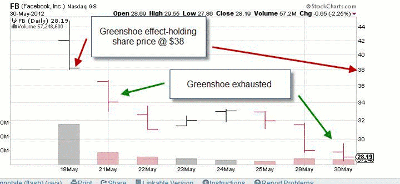Alan Ellman of The Blue Collar Investor describes the “greenshoe effect,” a condition that takes hold over the market price of new IPOs. Its impact is especially noticeable in Facebook’s (FB) young history.
When studying covered call writing, we learn to master stock investing as well as option trading basics. Then we become elite investors by focusing in on the inter-relationship between the two.
In this regard, a story most of us have been following the past two weeks has been the initial public offering (IPO) of Facebook (FB). The initial sale price was set at $38 on May 18. After opening, the stock price skyrocketed to $45 and settled at the end of the first day of trading right at $38 where it began. Was this a coincidence?
At the time I started writing this article, the price was down to $28.19. This week’s article will explore the role of options in the price behavior of Facebook on that first day and introduce the “greenshoe option,” which perhaps is a new name to many readers.
Greenshoe Definition
A greenshoe option is a provision contained in an underwriting agreement that gives the underwriter (Morgan Stanley was the main underwriter, in this case) the right to sell investors more shares than originally planned by the issuer (Facebook, in this case).
The purpose is to provide price stability, as the underwriter has the ability to increase supply and compensate for price fluctuations if demand increases.
The Facebook Story
On May 18, Morgan Stanley sold 484 million shares of FB at $38 per share and simultaneously bought 421 million shares from the company and investors at $37.58, generating an initial 1.1% profit, which represented the underwriter’s fee. Not bad!
In essence, Morgan Stanley shorted 63 million shares of FB, which represents the greenshoe. From Facebook’s perspective, shorts eventually need to be covered, resulting in upward pressure on the stock price. It also provides market liquidity if there is great demand for the stock.
Now, from Morgan’s perspective, this was not truly a “naked short” because of the greenshoe option, which gave them the right to go back to Facebook and purchase an additional 63 million shares at $38 (less fees). So what were the possibilities?
- The IPO is a huge success and the price moves higher. Then Morgan sells those shares to the anxious buyers
- The IPO is a dud and the price declines. Now Morgan will cover the short by buying back shares at market price. This buying action will tend to support the share price, at least for that first day.
It was, in fact, no coincidence that on May 18, whenever the price declined to around $38, large blocks of shares were purchased.
To further support this scenario, look at these stats from Friday, May 18:
- 43 million shares were bought at exactly $38 per share
- 28.5 million shares were purchased at $38.01
Common sense tells us that most of that buying was Morgan Stanley attempting to support the share price of an unsuccessful IPO.
On Monday, May 21, it appears that the greenshoe was exhausted, as the price plummeted to $34 as shown on the chart below:
Practical Application
When an IPO is introduced, there is a lot of speculation and excitement regarding the direction and strength of price movement. Many retail investors will buy a stock like Facebook because it is ubiquitous and synonymous with success. It’s (understandably) tempting to hand over our hard-earned cash to be part of the American dream.
Now, with the knowledge of the role of greenshoe options for the underwriters, we can watch the price action of the stock on the first day of trading. An initial pop is understandable, and almost expected. When we subsequently see a drop in share price and then buying to keep the price at or about the original IPO price, however, we can infer that the greenshoe effect is kicking in.
That gives us an opportunity to get out at the $38 price. True, that may be a loss, but $38 seems a whole lot better than the under $28 price I’m staring at as I type these words.
Conclusion
Covered call writing is not only a great investment strategy for many investors, but it also represents a fabulous educational background to learn and understand the practical application of stock and option investing.
Although the Facebook story is not directly related to our covered call investing at this point in time, it does represent an interesting story where we can put our knowledge and skills to practical use in understanding a dynamic that few others can comprehend.
Note: The term “greenshoe” comes from Green Shoe Manufacturing, the first company to allow underwriters to use this strategy. This is the company we know today as Stride Rite Corp.
By Alan Ellman of The Blue Collar Investor
Were you among the traders who participated in the Facebook IPO? Share your thoughts and experience in the Comments section below.






















